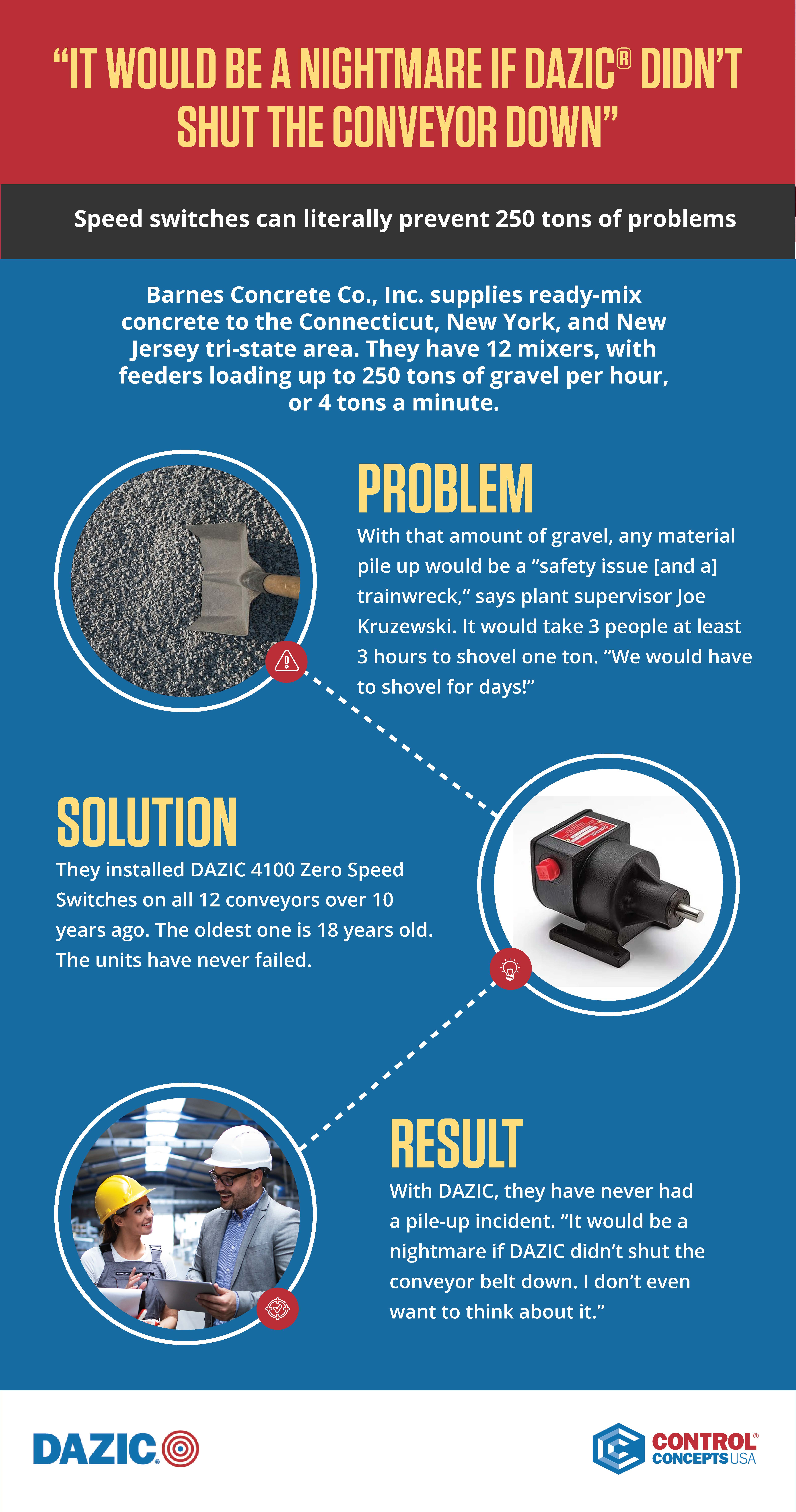AirSweep Saves R.M Palmer From a Sticky Situation
Comments Off on AirSweep Saves R.M Palmer From a Sticky SituationR.M. Palmer, a candy manufacturer in Reading, Pennsylvania, produces specialty holiday confections for US and international distribution. Some creations include novelties such as chocolate pumpkins, Easter bunnies, and Santas. The privately-owned company has been making confections for 50 years.
To make chocolate, cocoa powder is poured from 50-pound bags into a bag dump station with an integral dust collector. The powder is gravity-fed to a large storage hopper. From there, it moves to a smaller intermediate hopper that discharges into a rotary airlock, then is pneumatically conveyed to a weigh batching area.

Problem
Their cocoa powder is very fine and has a 12% oil content. It would pack, bridge and rathole in the intermediate hopper. Workers had to do manual cleaning every 3 or 4 days.
“It wasn’t a pretty sight,” said coatings manager Bob Wieland. After striking the hopper with a large mallet to loosen the powder, operators would open an access door.
“We had to reach through the door and scrape down the hopper walls with a plastic scraper,” Wieland said. “If you weren’t careful as you reached the door, the powder could fall on you and turn you into a giant cocoa puff! We had some pretty big spills in the past.”
Solution
Wieland saw an advertisement for a bin discharge system that injects air pulses between the material and vessel wall to lift and sweep material off slopping surfaces. Wieland was wary of all bin discharge system claims by then, but he liked AirSweep’s trial period and guarantee.
“A lot of manufacturers say their product will work but they don’t back it up,” Wieland said. “I told the rep that I’d used three other units with no luck, and he guaranteed the system would work or I wouldn’t have to pay for it. Their trial period allowed 30 days to install the bin discharger and 30 more to use it. I couldn’t go wrong.”
Two AirSweep VA-06 food-grade units were installed 180 degrees apart, 1.5 feet above the hopper outlet. Special couplings mounted the units to the hopper’s curved surface. A CB04-4 programmable sequence timer with NEMA 4 enclosure triggered alternating ¼-second air pulses every 20 seconds.
This solved the mounting problem and all 24 VA-06 units were attached. Holes were drilled into the refractory, then mounted with rings on top of the incoming duct.
Results
The plant went from downtime every 3 or 4 days to “no breakdowns, replacements, or any problems whatsoever.” They were even able to add two production shifts per month, increasing output.
“AirSweep works,” Wieland said. “It has a stronger air pulse than the bin aerators or fluidizers we previously installed. The air moves the powder down in a very large column so powder doesn’t stick to the walls.”
AirSweep was also more convenient and cost-efficient than other flowaids. “It’s very quiet; you hardly hear it run. The sequence times saves plant air. The system installed very easily and is built very simply.”
AirSweep runs three shifts per day, 7 days per week. Through increasing productivity and lower energy and maintenance costs, they were able to recover the system’s cost after just two months of operation.
Airsweep System Keeps Lithium Carbonate Flowing In The Desert Of Northern Chile
Comments Off on Airsweep System Keeps Lithium Carbonate Flowing In The Desert Of Northern ChileIn Chile, Albemarle Ltd. is the second leading converter of lithium brine into lithium chloride and lithium carbonate. The production process begins with the treatment of natural brine that is obtained by pumping from the core of the Salar de Atacama and is available in open air pools, which are subjected to the intense solar energy of the Atacama Desert.
The natural brine used by Albemarle for its process contains a lithium concentration close to 0.2%. Due to evaporation produced by the sun, the brine becomes more concentrated and moves between different pools until reaching a 6% lithium content.
The concentrated brine is transported in tank trucks to the La Negra Chemical Plant in Antofagasta. Here, the brine extracted from the Salar de Atacama is subjected to a series of purification and chemical processes to produce products such as Lithium Carbonate-Battery Grade which is used in electronic devices, electric cars, and safety equipment, among others.
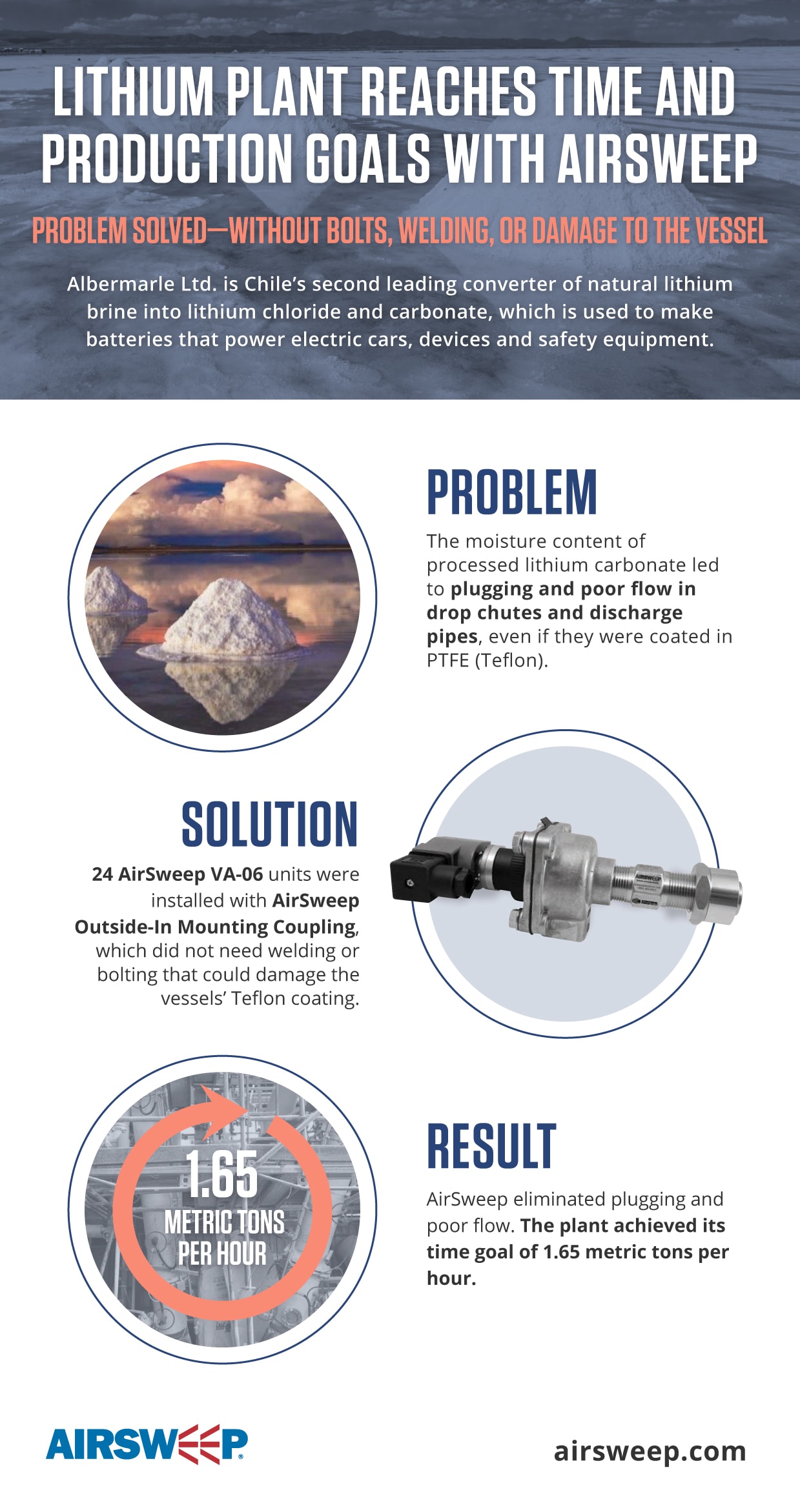
Problem
Poor flowability of processed lithium carbonate through drop chutes and a discharge pipe was an ongoing problem for the Albemarle La Negra Plant due to the product’s high moisture content. While maintaining a powder/talc consistency, the moisture content of lithium carbonate is 10-25%, with a density of 35-100 lbs/ft3 (561-1601 kg/m3).
Lithium Brine Beds – Salar de Atacama Region in Chile Hammers were being used to loosen processed materials that were stuck in the drop chutes. The chutes measure 10″ (25.4 cm) in diameter with stainless steel walls lined with PTFE (Teflon). From the drop chute/discharge pipe system, bins were filled using a screw feeder, which discharged to various silos.
Solution
Initially, twenty-four (24) Model VA-06 stainless steel AirSweep units were proposed for this project. Upon closer scrutiny, the typical welding and bolting installation methods of the VA-06 standard mounting coupling could not be used due to the PTFE-coated interior walls of the drop chute. Control Concepts recommended the AirSweep Outside-In Mounting Coupling, which allows AirSweep units to be attached to vessels without welding or bolting.
This solved the mounting problem and all 24 VA-06 units were attached. Holes were drilled into the refractory, then mounted with rings on top of the incoming duct.
Results
Michelle Williams, Senior Project Manager of the Albemarle La Negra plant, reported their material filling time goal of 1.65 metric tons per hour was achieved due to the AirSweep system eliminating the material plugging and poor flow.
Additionally, the operators could finally “Drop The Hammers!” After successful initial trials, two more projects have been purchased and installed, with new applications being considered.
Cleared For Take Off
Comments Off on Cleared For Take OffAn aviation services company gets perfect material flow—and first-class customer service
The Federal Aviation Administration (FAA) requires airlines and airports that operate during icy conditions to perform deicing and anti-icing of aircraft and airfield pavement. Frozen deposits can lead to loss of control, engine flameout, and other accidents. An aviation services company that helps to deice gates, ramps, and other critical equipment for over a hundred airports across the United States had to clear their material blocks, before they could clear the runway.
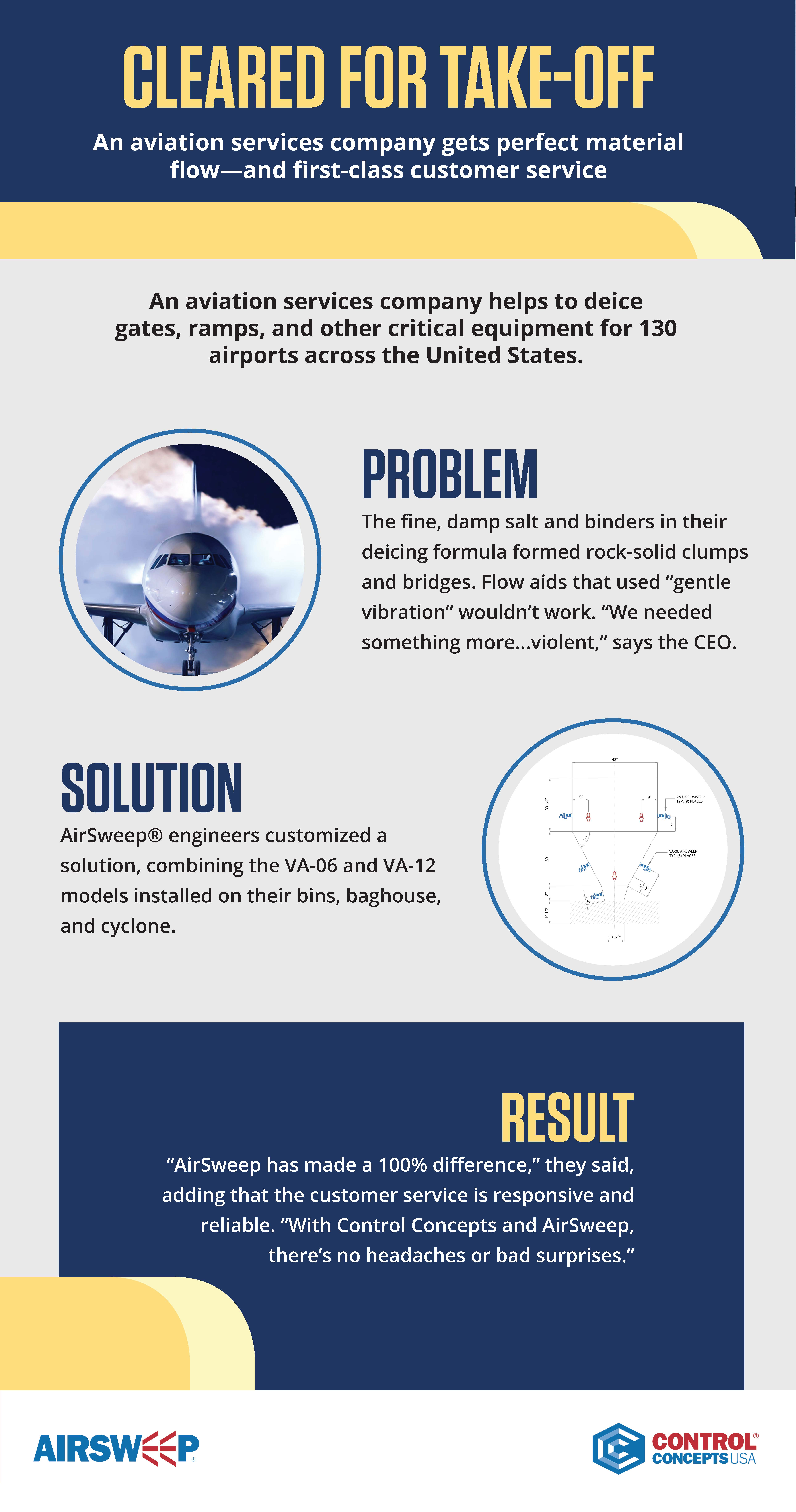
Problem
The company blended salt with binder and other additives to make pellets, which were irregularly shaped to prevent them from rolling or blowing off the runways. Unfortunately, many materials used in deicing formulas are hygroscopic, and have a tendency to clump and harden.
The company’s process engineer suggested vibrators. But after the maintenance supervisor saw its description of “gentle vibration,” he knew it wouldn’t work.
“We needed something more…violent,” said the company’s CEO.
Solution
The aviation services company searched online and upon watching the video of the AirSweep® material flow aid system, knew it was exactly what they were looking for. AirSweep® engineers customized a solution that took into account their process, size, and angle of the vessels. This included:
- Two PM surge welded bins: Two VA-06 units placed at the upper half of the vessel, two VA-06 units in the center, and one VA-06 unit above the discharge
- Four minor welded bins: Four VA-06 units placed 90 degrees apart above the discharge
- Acetone bins: Four VA-06 units placed 90 degrees apart
- Receiving bins: Four VA-06 units placed 90 degrees apart
- Baghouse: Four VA-12 units placed 90 degrees apart
- Cyclone: Four VA-06 units placed 180 degrees apart
Results
“AirSweep has made a 100% difference to our materials flowing,” the aviation services CEO said. They are getting more units to install in their other business areas, where they serve other airlines—including the biggest carriers and package delivery services.
They’re also happy with the “first-class” customer service they’ve received. “From the very beginning, the Control Concepts team has been very responsive. Every quote is accurate, and I never have to ask ‘where is my stuff’? Because if I’m calling a company for an update, I’m already mad,” said the CEO.
“Finally, we’ve found a company on the same level of service as us. With Control Concepts and AirSweep, there’s no headaches or bad surprises.”
DAZIC speed switches can literally prevent 250 tons of problems
Comments Off on DAZIC speed switches can literally prevent 250 tons of problems“It would be a nightmare if DAZIC didn’t shut the conveyor down”
Local businesses can’t spend a lot of money on safety equipment—and they don’t have to. DAZIC Zero Speed Switches are used by a wide range of companies—from those in the S&P 500 to small family-owned businesses.
Barnes Concrete Co., Inc. has been manufacturing and delivering ready-mix concrete for 50 years. It started out as a small-batch plant with just three mixers. Now, they have 12 mixers and supply to the Connecticut, New York, and New Jersey tri-state area.
Problem
The feeder loads up to 250 tons of gravel per hour. Any equipment malfunction or failure in the production line could lead to an avalanche of material. “It’s really a safety issue,” said plant supervisor Joe Kruzewski. “It would be a train wreck [to be] buried with that amount of gravel.”
Solution
But they never had that problem because of the DAZIC 4100 Zero Speed Switches (CI 4120/B) they installed on all of their 12 conveyors, years ago. The oldest one is 18 years old, and it is still working!
DAZIC Zero Speed Switches are interlocked into a conveyor system so that operations stop if any equipment runs outside of pre-set speed limits. It prevents material pile-up, and its disastrous consequences.
Kruzewski estimates that it would take three people at least three hours to shovel one ton of gravel. The feeder loads 250 tons of gravel per hour, or about four tons a minute. If a machine fails, any delay in response time means hours of backbreaking cleanup. Even just a 10-minute delay could result in 30 hours of downtime. “We would have to shovel for days!”
Results
The DAZIC Zero Speed Switches used by Barnes Concrete cost less than $900 each, and have not broken down after more than a decade of use. “They have never quit. The mounting eventually fails from wear and tear, but that’s more of maintenance on our part, not from the unit failing,” says Kruzewski.
But most importantly, the cement plant has not had a single incident of material pileup.
“It would be a nightmare if the DAZIC didn’t shut the conveyor belt down. I don’t even want to think about it,” Kruzewski said.
AirSweep: Zero Buildup, Easy Clean Up
Comments Off on AirSweep: Zero Buildup, Easy Clean UpAirSweep is the only flow aid that can be used for both material flow and vessel cleaning—saving time and money at all stages of production.
The AirSweep system has many uses and applications. Aside from promoting on-demand flow, it can keep materials from adhering to the inside surfaces of process equipment to help ensure batch uniformity, and also clean and flush vessels between production runs. This reduces the time needed for final, manual cleaning—and for some industries, it can help protect product quality and safety.
Problem
An infant formula manufacturer produces several formulations in the same processing and packaging lines. They rely on a labor-intensive, multi-step process of flushing and manual cleaning because even trace amounts of cross-contamination may compromise the next batch and affect their consumers. They couldn’t take risks with a baby’s health.
Formula blends use ingredients containing high fat, sugars, and proteins that tend to cling to process vessel walls and inner surfaces. Some vitamin and mineral compounds also segregate out of the blends, causing out-of-spec formulations in the final product. This results in some batches of finished product to be scrapped or re-blended.
Solution
The manufacturer installed AirSweep USDA 135 and 185 and Straight Shooters in their blenders, vacuum receivers, sifters, and packaging line vessels. By pulsing the AirSweep units during and after the batch runs, they found that the powerful air pulses swept the vessel walls and inner surfaces of residual powder buildup. This made a significant, positive impact on blend uniformity and dramatically lessened the labor and time needed to clean after the batch runs were completed. This allowed them to add batch runs and increase production output.
Results
AirSweep helped prevent material buildup during, and after, the process—proving its versatility and value.
“Beyond reliably producing a consistent product, they’ve also cut their turnaround and cleaning time significantly—saving tons of money,” said Paul Rose, AirSweep’s Sales Director. After the initial pilot test in one facility in 2016, they have since added AirSweep units to the other process lines in that plant, and in four other plants worldwide, and are currently adding the system to other plants.
“We went from 40 hours to 10 hours in cleanup time,” said the Company’s Associate Director for Process Technology Application and Productivity.
AirSweep Proven to Be More Powerful Than Air Cannons for Cement Materials
Comments Off on AirSweep Proven to Be More Powerful Than Air Cannons for Cement MaterialsMany of the raw materials used in cement are prone to caking and material blocks. They stick on chutes, clump up in storage silos, and cling to tubes and vessel walls.
Heidelberg Cement, one of the largest building materials companies in the world, faced this exact problem in its production line.
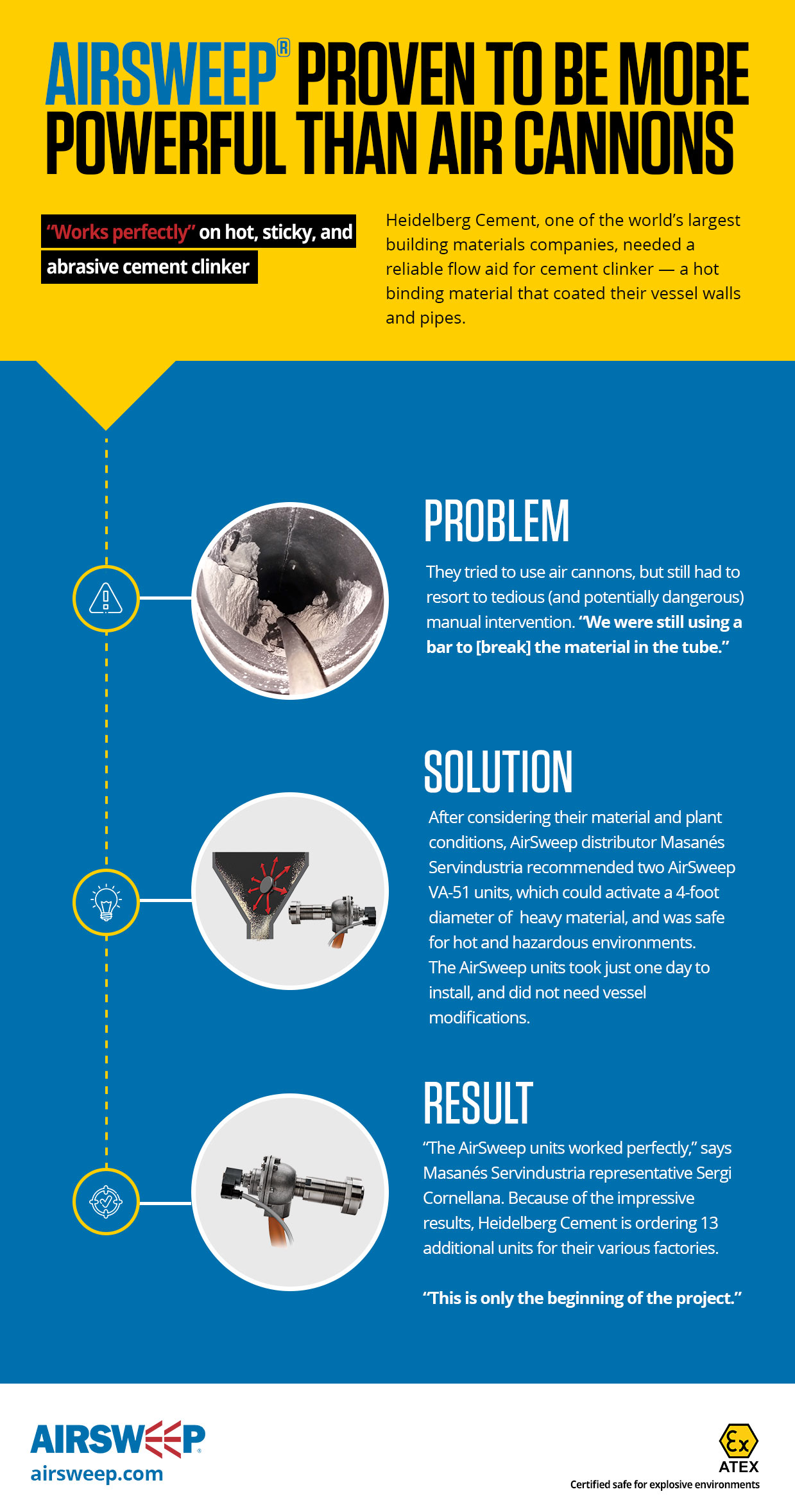
Problem
During cement production, crushed rock is combined with iron ore and fly ash, then melted at 2,700F in a kiln. One of the by-products of this process is clinker: gray marble-sized balls that are passed through coolers, then ground and mixed with other materials to be used as cement binder.
Clinker is a hot, sticky, and abrasive material that tends to cling to vessels and chutes. Heidelberg Cement tried to blast through the blocks with two AIRCHOC air cannons.
It didn’t work.
Human intervention was still needed to fix the issue. “We were using a bar to [break] the material in the tube.”
Solution
Heidelberg Cement needed a more reliable material flow aid that could eliminate all material blocks. They contacted Masanés Servindustria — a provider of conveyors, belts, and other accessories for bulk solids processing and transport. The Company is the official distributor of AirSweep® in Spain.
Sergi Cornellana, a Masanés product manager, assessed their process and recommended replacing the air cannons with two AirSweep VA-51 units. This is AirSweep’s largest and most powerful model. Each unit can activate the toughest and stickiest materials within a four feet radius and can even operate in hot or hazardous environments.
Results
“The AirSweeps worked perfectly,” says Cornellana. In fact, Heidelberg Cement was so happy with the results that in the last year, they ordered 13 additional units for their various factories. “This is only the beginning of the project.”
AirSweep was an effective, fast, and simple solution. They were able to install it themselves in less than a day — and from that point on, nobody had to worry about clogged clinker again.
The Little Speed Switch That Could
Comments Off on The Little Speed Switch That CouldThis article was originally published in Powder & Bulk Solids Magazine.
One of the world’s biggest manufacturers of sustainable, fiber-based products had been using Control Concepts’ DAZIC since the early 2000s. They produce paper, packaging, and pulp material for hygiene products, diapers, and pharmaceuticals. These products are exported to 25,000 customers in 150 countries.
In 2006, the company installed DAZIC 8100 switches on its conveyor belts. Years passed, plant managers changed, equipment changed, and the DAZIC switches kept on running. The switches worked so well that people forgot they were even there.

The Problem
In 2019, the fiber-based manufacturer changed its conveyor belts but did not check the DAZIC speed switch. Months passed before a sludge build-up was noticed. It wasn’t enough to stop operations, but as a precaution, the company sent it to Control Concepts to have it checked.
The Solution
The DAZIC team opened the speed switch and found that all its parts were still working perfectly, but it was clogged with black, oily residue. They cleaned it up, and the speed switch was good as new. But DAZIC engineers wanted to find out the cause of the clogging, so they looked into how it was installed and what could have affected its performance. They discovered that the new conveyor belts had a quick start-up, which was incompatible with the DAZIC 8100 model the client was using.
The 8100 Series Zero Speed Switches are designed for slow-speed applications, and shaft input speeds of 0.5 to 25 RPM. The wear-and-tear from carrying a load beyond its design specifications could have caused the leaks. Despite this, the 15-year-old switch was still working—just dirty.
The Results
DAZIC sent back the switch, shiny and ready to resume work. DAZIC also recommended the more appropriate CI 2120 10/B model for the new conveyor system.
After learning why the switch failed, the client was impressed by DAZIC’s durability and the team’s commitment to find the cause of the problem and work on a better solution. “We have used DAZIC in many of our plants for nearly two decades. It is a brand and a company you can trust.”
The company continues to use DAZIC in all of its plants around the world.
Speed Switches That Never Stop
“We take pride in DAZIC’s durability and dependability. We have numerous customers that have used the same switches for over a decade,” said Henry Tiffany, president of Control Concepts Inc., the manufacturers of DAZIC.
But for DAZIC to work efficiently, and prevent any equipment damage, it’s important to get the right speed switch for your application. That’s why Tiffany recommends contacting the company if you make any changes to the process or equipment.
The DAZIC team can then select the right model and show you how to properly mount and align it to prevent putting any extra load on the bearings.
“This is part of our commitment to customer service and shows how much we stand by the quality of our products,” said Tiffany.
Major Electric Utility Solves Dry Sorbent Injection (DSI) Material Flow Problem
Comments Off on Major Electric Utility Solves Dry Sorbent Injection (DSI) Material Flow ProblemA major electric utility’s coal-fired plant in the Midwest needed to meet Federal emissions standards while keeping power output maximized. This 2600 MW plant contained a pair of the largest coal-fired generators in the U.S. To meet Federal emission standards, the plant installed a Dry Sorbent Injection (DSI) system designed to mitigate hydrogen chloride (HCI) and sulfur dioxide (SO2) flue gas emissions.

Problem
DSI technology relies on bulk solid materials that exhibit poor flow properties, such as Hydrated Lime, Trona, Soda Ash and Sodium Bicarbonate. At this generating station, the process feeding the powdered material to the DSI system consisted of a 5-foot diameter mixer connected to three legs of parallel screw conveyors. Materials were dropped three stories via an array of rotary valves, screw conveyors and hoppers, then to a final dilute-phase pneumatic conveyor that supplies the DSI system. There were a total of two of these DSI systems (one per each 1300 MW generator), so the opportunities for flow problems were doubled, given the amount of twists, turns, and distance the powder needs to reliably travel in order to keep the system running properly. The company faced significant penalties and fines of millions of dollars if emissions from the plant were not up to compliance standards.
Solution
The utility contacted Control Concepts, Inc., manufacturer of the AirSweep® Material Activation System. The AirSweep system has become the default flow aid choice among many manufacturers of proprietary DSI systems, as well as among some of the major manufacturers of DSI materials used in those systems. These manufacturers know that the AirSweep system can provide on-demand flow of a wide variety of DSI materials, including Hydrated Lime, Trona, Soda Ash, Calcium Carbonate, Sodium Bicarbonate and others. Each AirSweep nozzle delivers a powerful pulse of air or inert gas, knifing between the material and the inner contact surface of the vessel, chute, duct, etc., to break friction and immediately restore flow. Control Concept’s key Midwest distributor worked closely with the utility and the generating plant’s personnel to design an effective system. An AirSweep system was installed consisting of Model VA-51 nozzles mounted on the vessels, and Model VA-06 nozzles mounted in the numerous possible chokepoints in the ducts, screws and elbows. All nozzles installed were constructed from 316 Stainless Steel to resist corrosion. Local controllers were provided, tying into the plant’s DSL system to start and stop the system depending upon the need for DSI material.
Results
The generating plant has been running continuously and at capacity since autumn of 2015, with no compliance issues, thanks to the DSI system and assistance from the Airsweep Material Activation System.
Airweep® Solves a 4-Year-Old Material Flow Problem in Just 2 Weeks
Comments Off on Airweep® Solves a 4-Year-Old Material Flow Problem in Just 2 WeeksManual cleaning wasted time, money, and most importantly, put their workers at risk
Asphalt is made from aggregates, sands and asphalt cement. The materials have a tendency to conglomerate and compact in the silos. However, other flow aids like electric vibrators actually pack the material even more.

Problem
This was exactly what happened in the Mexico plant of a regional manufacturer of asphalt products. Despite having electric vibrators, plant workers still had to hit silos with a hammer or climb into the vessel to clean them.
“Over the weekend, when the plant was unstaffed, the asphalt materials would settle completely. When workers returned on Monday, they had to climb seven meters down into the dark silo, and clear thick layers of compacted material just to get the factory running again,” said the Sales Manager.
Their “Monday Morning Cleanup” wasted time, money, and most importantly, put their workers at risk. The company wanted to show their employees that they cared about their safety, and traded the hammers for an effective and reliable material flow aid system.
Solution
Control Concepts sent the AirSweep system for a free trial. The system was customized according to their client’s process and vessel size. The AirSweep Model VA-51 unit was ideal for large silos, and had the power to activate 6 to 8 feet (1.8 m to 2.4 m) of heavy material with one pulse. Eight units were positioned to ensure first-in/first-out on-demand flow.
The cones were made of concrete, but the engineer visited the site and quickly resolved the issue. After inspecting the vessel, he recommended adding a metal sheet – a cheap, fast and effective workaround.
Results
After two weeks, the plant manager called. “After four years, we finally have the right solution! We are very happy with the system.” They have saved time, energy, money from maintenance costs and losses from downtime. Workers were safe and free to focus on their real jobs. They are looking to install units in their other plants – and retiring the hammers for good.
AirSweep System Fixes Several Flow Issues Along Titanium Dioxide Processing Network
Comments Off on AirSweep System Fixes Several Flow Issues Along Titanium Dioxide Processing NetworkAirSweep® boosts productivity and cuts batch time to 15 minutes
In an effort to produce a better quality product, a major international paint and coatings manufacturer needed to use a new grade of Titanium Dioxide (TiO2). A test of the material showed that the new grade of TiO2 presented flow problems not previously encountered with the existing grade.
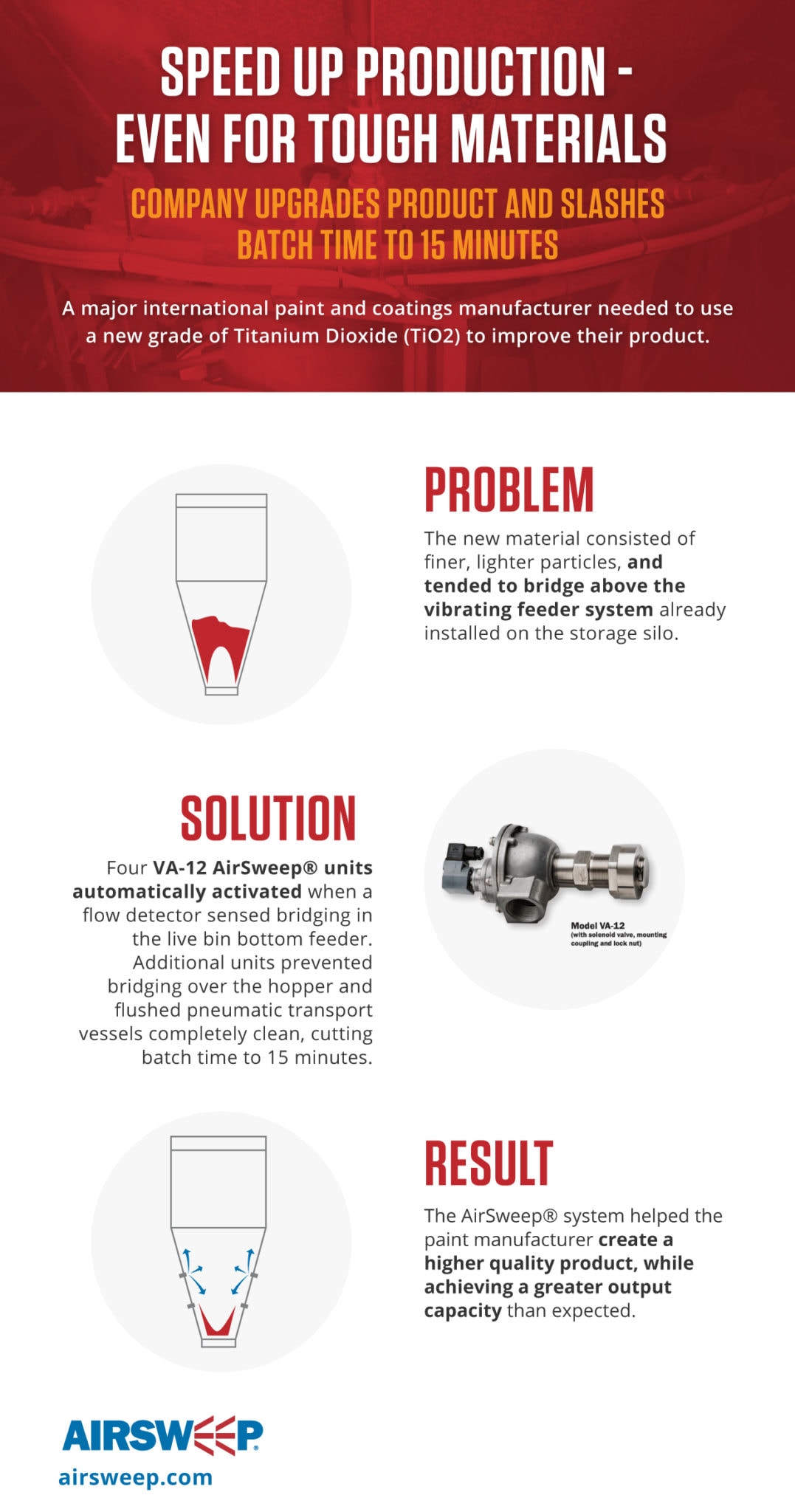
Problem
The new material consisted of finer, lighter particles, and tended to bridge above the vibrating feeder system already installed on the storage silo.
Solution
To correct the problem, the company replaced the feeder with a live bin bottom (multiple screw feeder) and installed a ring of four Model VA-12 AirSweep units about 2 feet above the live bottom. These were automatically activated when a flow detector sensed bridging above the live bottom.
The flow of TiO2 from the live bottom system was now feeding beyond the capacity of the system’s screw conveyor. A collection hopper was put into service as a buffer hopper to feed the screw but the material would immediately bridge above the 10″ diameter outlet. This was solved by installing an additional four VA-12 AirSweep units on the buffer hopper.
The new grade of TiO2 also caused flow problems in the pneumatic transport vessel. The material proved difficult to aerate and the vessel would not completely empty during the batch cycle. In order to completely empty the vessel, the transport cycle needed to be activated two or three more times, taking up to 50 minutes to transport the entire batch over a distance of 325 feet. After installing four VA-12 AirSweep® units, the pneumatic transport vessel completely emptied in only one cycle, cutting the batch time to only 15 minutes.
Results
The AirSweep system helped the paint manufacturer create a higher quality product, while achieving a greater output capacity than expected.

